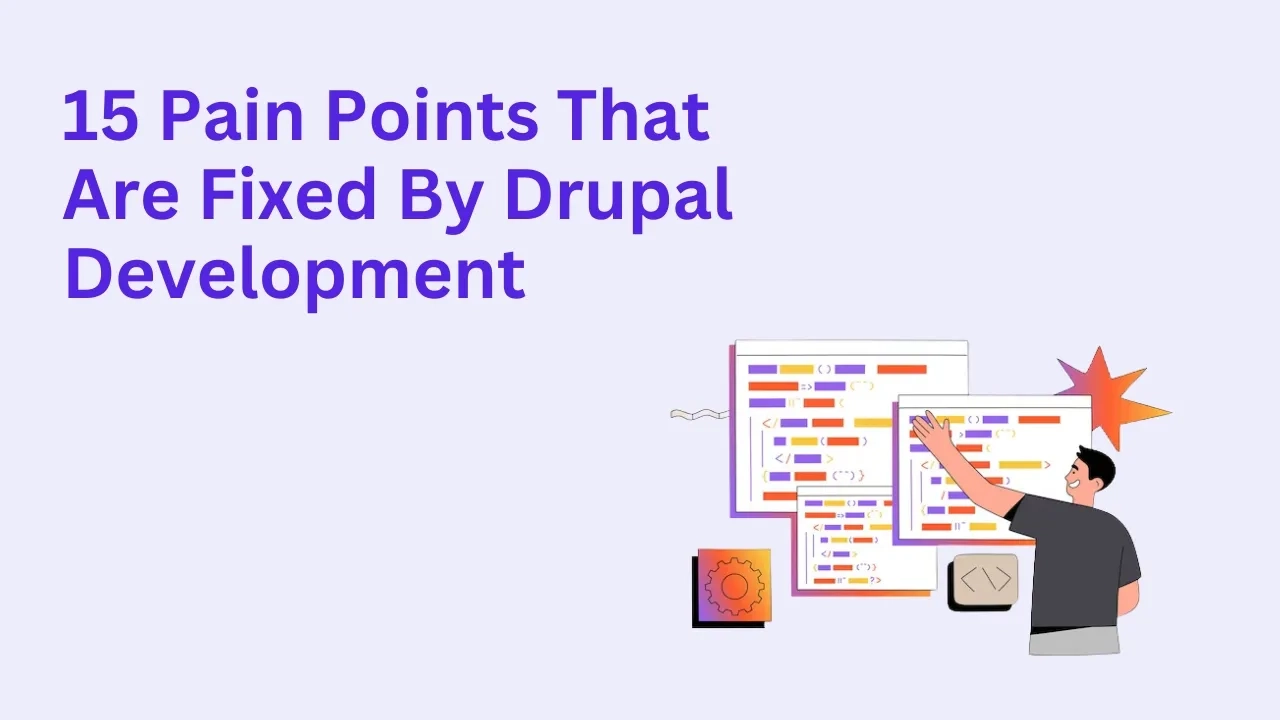15 Pain Points That Are Fixed by Drupal Development

Businesses today face numerous challenges when managing their websites, from security threats to scalability issues. Drupal development has emerged as the ultimate solution to address these pain points effectively. With its robust features, flexibility, and open-source nature, Drupal empowers businesses to overcome digital hurdles seamlessly.
In this blog, we’ll explore 15 pain points that are fixed by Drupal development and how it helps businesses achieve a secure, scalable, and high-performing website.
1. Fixing Website Security Challenges with Drupal
Security remains a top concern for businesses operating in the digital space. Drupal is known for its strong security standards and ability to combat vulnerabilities.
- Drupal comes with built-in security modules like database encryption and user authentication.
- Regular security updates provided by the Drupal community ensure ongoing protection against threats.
- Drupal’s role-based access control limits permissions to authorized users, reducing risks.
Many organizations, including government websites, trust Drupal for its airtight security.
Learn more about Drupal’s security measures here.
2. Solving Scalability Issues for Growing Websites
As businesses grow, their websites must scale to handle increasing traffic and content. Drupal excels at scalability by:
- Supporting high-traffic websites without compromising performance.
- Offering advanced caching techniques like Varnish and BigPipe.
- Providing tools to optimize databases and content delivery for larger websites.
Whether you’re a small business or an enterprise, Drupal development ensures your site scales seamlessly.
3. Resolving Content Management Complexities
Managing complex content can be challenging for organizations with diverse resources. Drupal simplifies this with:
- Flexible content types to organize blogs, videos, and documents.
- User-friendly editorial workflows for content creation and approvals.
- Powerful taxonomy systems to categorize content intuitively.
Drupal’s CMS capabilities allow businesses to deliver engaging content efficiently.
Also read : Why Drupal for Travel Websites Would Be a Game Changer?
4. Addressing Performance Bottlenecks
Slow websites hurt user experience and SEO rankings. Drupal resolves performance issues by:
- Implementing advanced caching mechanisms for faster load times.
- Optimizing code and content delivery.
- Supporting content delivery networks (CDNs) for global performance.
With Drupal, you ensure a fast and seamless browsing experience for users.
5. Improving SEO and Search Engine Rankings
SEO is critical for online visibility. Drupal offers:
- SEO-friendly URLs and meta tag optimization.
- Fast page load speeds, improving search rankings.
- Tools like Pathauto and Meta Tag modules for better SEO management.
With Drupal, businesses can achieve higher search engine rankings effortlessly.
6. Overcoming Multilingual Content Challenges
For global businesses, multilingual content is essential. Drupal simplifies this with:
- Built-in multilingual support for multiple languages.
- Automatic translation tools for seamless content delivery.
- Improved accessibility for users in different regions.
Drupal makes managing a multilingual site efficient and hassle-free.
Also read : Why Is Drupal The Best Choice For Healthcare Business?
7. Streamlining Integrations with Third-Party Tools
Integrating tools like CRMs, ERPs, and APIs can be complicated. Drupal resolves this by:
- Offering seamless API integrations.
- Supporting tools like Salesforce, HubSpot, and Google Analytics.
- Ensuring smooth data flow across platforms for enhanced functionality.
Drupal integrates with third-party tools effortlessly to enhance website performance.
Learn about Drupal integrations here.
8. Fixing Mobile Responsiveness Problems
Mobile-first design is essential for modern businesses. Drupal ensures:
- Responsive themes that adapt to different devices.
- Mobile-optimized content delivery for improved UX.
- Faster load times on smartphones and tablets.
Drupal development guarantees an excellent experience on mobile devices.
9. Improving User Experience (UX) on Websites
User experience determines visitor retention and satisfaction. Drupal improves UX with:
- Intuitive navigation structures for easy browsing.
- Clean, responsive designs tailored to user needs.
- Accessibility tools that make the site inclusive for all users.
A well-designed Drupal site ensures users stay engaged and satisfied.
10. Simplifying Complex Customization Needs
Businesses often need custom solutions. Drupal development provides:
- Modular architecture for tailor-made solutions.
- Custom themes and templates to match brand identity.
- Unique workflows for specialized business needs.
Drupal’s customization capabilities adapt to any business challenge.
Also read : How to Ensure Security in Drupal Websites?
11. Ensuring Website Reliability and Reducing Downtime
Website downtime costs businesses valuable traffic and revenue. Drupal ensures reliability with:
- High-performance architecture for continuous uptime.
- Tools for load balancing and performance optimization.
- Reliable hosting solutions to keep websites running smoothly.
Drupal reduces downtime and ensures consistent performance.
12. Enhancing Content Personalization Capabilities
Content personalization is key to engaging audiences. Drupal allows businesses to:
- Deliver dynamic content based on user behavior.
- Use personalized dashboards and landing pages.
- Integrate data-driven tools for improved personalization.
13. Reducing High Website Maintenance Costs
Drupal is open-source, making it cost-effective:
- No expensive software licenses.
- Lower maintenance costs with regular updates.
- A robust community offering free support and resources.
Businesses save significantly with Drupal development.
Explore Drupal’s community resources here.
14. Streamlining Workflow Management for Teams
Managing workflows can be tricky for larger teams. Drupal simplifies it with:
- Content moderation tools for approvals and publishing.
- User roles and permissions for streamlined collaboration.
- Integration with task management tools for efficiency.
Drupal improves collaboration and workflow efficiency.
15. Simplifying Data Management for Large Websites
Handling large volumes of data can be overwhelming. Drupal simplifies data management with:
- Tools for structured content and large databases.
- Scalability to handle increasing content volumes.
- Features like Views and Taxonomy for content organization.
With Drupal, businesses can manage vast data seamlessly.
Conclusion: Why Drupal Development Resolves Critical Pain Points for Businesses
Drupal development is a game-changer for businesses looking to overcome website challenges. From fixing security issues and improving scalability to enhancing user experience, Drupal provides a comprehensive solution to all digital pain points. With its robust features, customization capabilities, and community support, Drupal ensures your website remains secure, scalable, and future-ready.
Ready to fix your website challenges? Explore how Drupal development can transform your online presence today! Visit our Drupal development services to get started.








